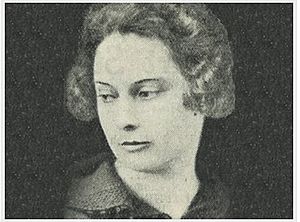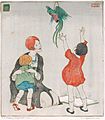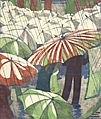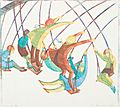Ethel Spowers facts for kids
Quick facts for kids
Ethel Spowers
|
|
|---|---|
 |
|
| Born |
Ethel Louise Spowers
June 11, 1890 South Yarra, Melbourne, Australia
|
| Died | 5 May 1947 (aged 56) |
| Education | National Gallery Art School, Melbourne Grosvenor School of Modern Art, London |
|
Notable work
|
Wet Afternoon (1930) |
| Style | Grosvenor School (linocut sub-category) |
| Movement | Modernism |
Ethel Louise Spowers (born 11 July 1890, died 5 May 1947) was a talented Australian artist. She is famous for her unique linocut prints. These artworks are so good that they are kept in important art galleries in Australia and Britain. Ethel also helped start the Contemporary Art Society to support new and exciting art in Australia.
Contents
Ethel's Early Life
Ethel Louise Spowers was born on 11 July 1890. Her birthplace was South Yarra, a suburb of Melbourne, Australia. Her father owned a newspaper, and her family was well-off.
Ethel went to the Melbourne Girls Grammar School. She later studied art at the National Gallery of Victoria Art School from 1911 to 1917. She also traveled to Paris to learn more about art. Her family had a large house in Toorak, where Ethel lived and had her own art studio.
Ethel's Artistic Journey
Ethel Spowers had her first art show in Melbourne when she was 30. She showed beautiful fairy-tale drawings. She had two more shows in 1925 and 1927. By then, she was also making woodcuts and linocuts. These were inspired by Japanese art and covered many different topics.
Learning Linocut Art
Ethel's art style changed a lot in 1928–29. She went to London to study linocut printmaking. She learned from a famous teacher named Claude Flight at the Grosvenor School of Modern Art. Many Australian women artists, like Dorrit Black and Eveline Winifred Syme, also studied there.
She took more classes in 1931. Here, she learned about modern art ideas. These included rhythmic design and how to arrange elements in her art.
Her Unique Linocuts
In the 1930s, Ethel's linocuts became very popular. People loved their bold shapes and simple designs. Her art showed a great sense of movement and used colors in a special way. She often captured funny moments from everyday life, especially scenes with children. Her works were often shown at The Redfern Gallery in London.
In 1930, Ethel organized an exhibition of Australian linocuts in Melbourne. In 1932, she helped create the Contemporary Art Society. This group aimed to promote modern art in Australia.
Famous Artworks by Ethel Spowers
Here are some of Ethel Spowers' well-known artworks:
- Yallourn (1933)
- Bank holiday (1935)
- Resting models (1933)
- Wet afternoon (1930)
- Gust of Wind (1931)
Ethel's Legacy
Ethel Spowers passed away on 5 May 1947, at age 56. She had been ill for a long time. A children's book she illustrated, Cuthbert and the Dogs, was published after her death.
Some of her artworks have sold for very high prices. In 2011, her linocut Wet Afternoon sold for over £51,000. The next year, The Gust of Wind sold for over £114,000. This was a record price for a Grosvenor School print at that time.
Where to See Her Art
Many art galleries proudly display Ethel's works. The Art Gallery of New South Wales has some of her early realistic drawings. They also have pieces that show the strong influence of her time at the Grosvenor School.
The National Gallery of Australia holds 47 of her prints. These were made in the 1920s and 1930s. Her prints are also found in the National Gallery of Victoria and the Art Gallery of Ballarat. The British Museum and the Victoria and Albert Museum in London also own many of her linocuts.
Gallery
-
Ethel Spowers, The plough, 1928, linocut. Gift of Rex Nan Kivell, 1953. Museum of New Zealand Te Papa Tongarewa (1953-0003-327)
-
Ethel Spowers, Wet afternoon, 1930, linocut. Gift of Rex Nan Kivell, 1953. Museum of New Zealand Te Papa Tongarewa (1953-0003-328)
-
Ethel Spowers, Merchants, Port Said, 1932, linocut. Gift of Rex Nan Kivell, 1953. Auckland Art Gallery Toi o Tāmaki (1953/2/135)
-
Ethel Spowers, Harvest, 1932, linocut. Gift of Rex Nan Kivell, 1953. Auckland Art Gallery Toi o Tāmaki (1953/2/134)
-
Ethel Spowers, Swings, 1932, linocut. Gift of Rex Nan Kivell, 1953. Museum of New Zealand Te Papa Tongarewa (1953-0003-326)
-
Ethel Spowers, The Lonely Farm, 1933, linocut. Gift of Rex Nan Kivell, 1953. Auckland Art Gallery Toi o Tāmaki (1953/2/137)
-
Ethel Spowers, The giant stride, 1933, linocut. Gift of Rex Nan Kivell, 1953. Museum of New Zealand Te Papa Tongarewa (1953-0003-325)
-
Ethel Spowers, Football, 1936, linocut. National Gallery of Australia
-
Ethel Spowers, Children’s hoops, 1936, linocut. Gift of Rex Nan Kivell, 1953. Museum of New Zealand Te Papa Tongarewa (1953-0003-329)











